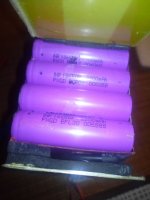eMark
100 kW
You bring up a very valid point that i've pondered over and why i decided not to use a BMS for the very reason you mention. Instead balance charge my Vruzend 10S3P pack. I have it wired so it can be paralleled as two 5S3P when balance charging. So have to ask this about that BMS ...Matador said:I think it's more likely the pack is out of balance from BMS parasitic drain. Think about it, a BMS with a 100 uA parasitic drain, stored for 3 years (3 x 365 day x 24h/days) that's still 2.628Ah drained off of one row of cells (enough to through the battery off balance). And if the pack performed great before storage but now poorly after storage, it's likely due to the BMS draining cells during that time where the battery pack was not particularly stressed.
Being the cells are all interconnected why shouldn't the BMS parasitic drain be similar among all the P-groups? So, still the uncertainty whether it's a disfunction with an inexpensive BMS or a few inferior cells? I do get your logic pointing to a BMS disfunction rather than a problem with just the cells in those two P-groups.
What's the best KIS way to determine whether it's a cell problem or BMS problem? Or are we safe to assume it's the BMS. Could that disfunctional BMS have been caused by some abuse to the battery pack?


